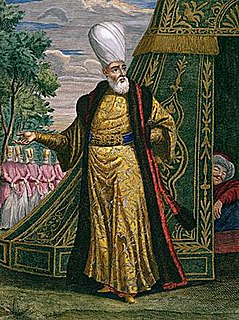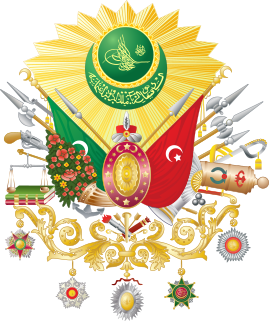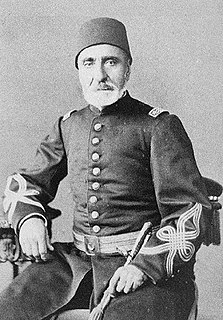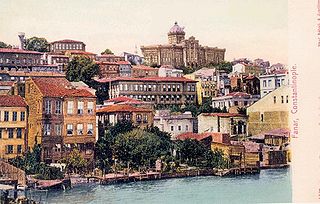 W
WThe Imperial Council or Imperial Divan, was the de facto cabinet of the Ottoman Empire for most of its history. Initially an informal gathering of the senior ministers presided over by the Sultan in person, in the mid-15th century the Council's composition and function became firmly regulated. The Grand vizier, who became the Sultan's deputy as the head of government, assumed the role of chairing the Council, which comprised also the other viziers, charged with military and political affairs, the two kadi'askers or military judges, the defterdars in charge of finances, the nişancı in charge of the palace scribal service, and later the Kapudan Pasha, the head of the Ottoman Navy, and occasionally the beylerbey of Rumelia and the Agha of the Janissaries. The Council met in a dedicated building in the Second Courtyard of the Topkapi Palace, initially daily, then for four days a week by the 16th century. Its remit encompassed all matters of governance of the Empire, although the exact proceedings are no longer known. It was assisted by an extensive secretarial bureaucracy under the reis ül-küttab for the drafting of appropriate documents and the keeping of records. The Imperial Council remained the main executive organ of the Ottoman state until the mid-17th century, after which it lost most of its power to the office of the Grand Vizier. With the Tanzimat reforms of the early 19th century, it was eventually succeeded by a Western-style cabinet government.
 W
WThe administrative divisions of the Ottoman Empire were administrative divisions of the state organisation of the Ottoman Empire. Outside this system were various types of vassal and tributary states.
 W
WAgha, also Aga, is an honorific title for a civilian or military officer, or often part of such title, and was placed after the name of certain civilian or military functionaries in the Ottoman Empire. At the same time some court functionaries were entitled to the agha title.
 W
WBeylerbey or Beylerbeyi was a high rank in the western Islamic world in the late Middle Ages and early modern period, from the Seljuks of Rum and the Ilkhanids to Safavid Persia and the Ottoman Empire. Initially designating a commander-in-chief, it eventually came to be held by senior provincial governors. In Ottoman usage, where the rank survived the longest, it designated the governors-general of some of the largest and most important provinces, although in later centuries it became devalued into a mere honorific title. Its equivalents in Arabic were amir al-umara, and in Persian, mir-i miran.
 W
WEvery sultan of the Ottoman Empire had his own monogram, called the tughra, which served as a royal symbol. A coat of arms in the European heraldic sense was created in the late 19th century. Hampton Court requested from the Ottoman Empire a coat of arms to be included in their collection. As the coat of arms had not been previously used in the Ottoman Empire, it was designed after this request, and the final design was adopted by Sultan Abdul Hamid II on 17 April 1882.
 W
WA divan or diwan was a high government ministry in various Islamic states, or its chief official.
 W
WDolmabahçe Palace located in the Beşiktaş district of Istanbul, Turkey, on the European coast of the Strait of Istanbul, served as the main administrative center of the Ottoman Empire from 1856 to 1887 and from 1909 to 1922.
 W
WA dragoman was an interpreter, translator, and official guide between Turkish, Arabic, and Persian-speaking countries and polities of the Middle East and European embassies, consulates, vice-consulates and trading posts. A dragoman had to have a knowledge of Arabic, Persian, Turkish, and European languages.
 W
WA firman, or ferman (Turkish), at the constitutional level, was a royal mandate or decree issued by a sovereign in an Islamic state, namely the Ottoman Empire. During various periods they were collected and applied as traditional bodies of law. The word firman comes from Persian فرمان meaning "decree" or "order".
 W
WThe General Assembly was the first attempt at representative democracy by the imperial government of the Ottoman Empire. Also known as the Ottoman Parliament, it was located in Constantinople (Istanbul) and was composed of two houses: an upper house, and a lower house.
 W
WHatt-i humayun, also known as hatt-i sharif, is the diplomatics term for a document or handwritten note of an official nature composed by an Ottoman Sultan. The terms come from hatt, hümayun (imperial) and şerif. These notes were commonly written by the Sultan personally, although they could also be transcribed by a palace scribe. They were written usually in response to, and directly on, a document submitted to the sultan by the grand vizier or another officer of the Ottoman government. Thus, they could be approvals or denials of a letter of petition, acknowledgements of a report, grants of permission for a request, an annotation to a decree, or other government documents. Hatt-ı hümayuns could be composed from scratch, rather than as a response to an existing document. After the Tanzimat reform (1856), aimed to modernize the Ottoman Empire, hatt-ı hümayuns of the routine kind were supplanted by the practice of irâde-i seniyye, in which the Sultan's spoken response was recorded on the document by his scribe.
 W
WThe Ottoman Empire used anthems since its foundation in the late 13th century, but did not use a specific imperial or national anthem until the 19th century. During the reign of Mahmud II, when the military and imperial band were re-organized along Western lines, Giuseppe Donizetti was invited to head the process. Donizetti Pasha, as he was known in the Ottoman Empire, composed the first Western-style imperial anthem, the Mahmudiye Marşı.
 W
WThe Imperial Government of the Ottoman Empire was the government structure added to the Ottoman governing structure during the Second Constitutional Era. The Committee of Union and Progress (CUP) was in power between 1908 and 1918. In this period, most of the ministers were also from the CUP.
 W
WA kazasker or kadıasker was a chief judge in the Ottoman Empire, so named originally because his jurisdiction extended to the cases of soldiers, who were later tried only by their own officers. Two kazaskers were appointed, called Rumeli Kazaskeri and Anadolu Kazaskeri, having their jurisdiction respectively over the European and the Asiatic part of the Empire. They were subordinated to the Grand Vizier, later Şeyhülislam, and had no jurisdiction over the city of Constantinople. Moreover, they attended the meetings at the Imperial Council.
 W
WKhedive was an honorific title of Persian origin used for the sultans and grand viziers of the Ottoman Empire, but most famously for the viceroy of Egypt from 1805 to 1914.
 W
WThe kodjabashis were local Christian notables in parts of the Ottoman Balkans, most often referring to Ottoman Greece and especially the Peloponnese. They were also known in Greek as proestoi or prokritoi or demogerontes. In some places they were elected, but, especially in the Peloponnese, they soon became a hereditary oligarchy, who exercised considerable influence and held posts in the Ottoman administration.
 W
WA mahallah, also mahalla, mahallya, mahalle Arabic: محلة, maḥallä, mahallā, mohalla, mehalla, or mehalle, is an Arabic word variously translated as district, quarter, ward, or "neighborhood" in many parts of the Arab world, the Balkans, Western Asia, the Indian subcontinent, and nearby nations.
 W
WA muḥtasib was a supervisor of bazaars and trade in the medieval Islamic countries. His duty was to ensure that public business was conducted in accordance with the law of sharia.
 W
WThe Ottoman Caliphate, under the Ottoman dynasty of the Ottoman Empire, was the last Sunni Islamic caliphate of the late medieval and the early modern era. During the period of Ottoman growth, Ottoman rulers claimed caliphal authority since 1517 since Selim I, through conquering and unification of Muslim lands, became the defender of the Holy Cities of Mecca and Medina which further strengthened the Ottoman claim to caliphate in the Muslim world since 1517.
 W
WPasha of Tripoli was a title that was held by many rulers of Tripoli in Ottoman Tripolitania. The Ottoman Empire ruled the territory for most time from the Siege of Tripoli in 1551 until the Italian invasion of Libya in 1911, at the onset of the Italo-Turkish War.
 W
WPhanariots, Phanariotes, or Fanariots were members of prominent Greek families in Phanar, the chief Greek quarter of Constantinople where the Ecumenical Patriarchate is located, who traditionally occupied four important positions in the Ottoman Empire: Voivode of Moldavia, Voivode of Wallachia, Grand Dragoman, and Grand Dragoman of the Fleet. Despite their cosmopolitanism and often-Western education, the Phanariots were aware of their Hellenism; according to Nicholas Mavrocordatos' Philotheou Parerga, "We are a race completely Hellenic".
 W
WThe Reis ül-Küttab, or Reis Efendi, was a senior post in the administration of the Ottoman Empire. Translated as "chief of the scribes" or "head clerk", the holder of the post was originally the head of the chancery of the Imperial Council, evolving into an analogue to a Foreign Minister. In 1836, the title of reis ül-küttab was formally changed to Foreign Minister with the establishment of the Ottoman Ministry of Foreign Affairs during the Tanzimat reforms.
 W
WRüstem Pasha was an Ottoman statesman who served as the Grand Vizier of sultan Suleiman the Magnificent. Rüstem Pasha is also known as Damat Rüstem Pasha as a result of his marriage to the sultan's daughter, Mihrimah Sultan. He is known as one of the most influential and successful grand viziers of the Ottoman Empire.
 W
WAli Pasha Mohamed Sherif was an Egyptian government official and a renowned breeder of Arabian horses during the late 19th century.
 W
WThe Sublime Porte, also known as the Ottoman Porte or High Porte, was a synecdoche for the central government of the Ottoman Empire.
 W
WThe Topkapı Palace, or the Seraglio, is a large museum in the east of the Fatih district of Istanbul in Turkey. In the 15th and 16th centuries it served as the main residence and administrative headquarters of the Ottoman sultans.
 W
WThe 1864 Vilayet Law (Ottoman Turkish: ولایت نظامنامهسی, Vilâyet Nizamnâmesi; French: Loi des vilayets, also known as the Provincial Reform Law, was introduced during the Tanzimat era of the late Ottoman Empire. This era of administration was marked by reform movements, with provincial movements led largely by Midhat Pasha, a key player in the Vilayet Law itself. The Vilayet Law reorganized the provinces within the empire, replacing the medieval eyalet system.
 W
WThe Grand Vizier of the Ottoman Empire was the de facto prime minister of the sultan in the Ottoman Empire, with absolute power of attorney and, in principle, dismissible only by the sultan himself in the classical period, before the Tanzimat reforms, or until the 1908 Revolution. He held the imperial seal and could convene all other viziers to attend to affairs of the state in the Imperial Council; the viziers in conference were called "kubbe viziers" in reference to their meeting place, the Kubbealtı ('under-the-dome') in Topkapı Palace. His offices were located at the Sublime Porte.